Shopping for healthy foods can be somewhat challenging and confusing these days. Most people purchase products based on what the package looks like and health claims put on the front. They don’t always read the ingredient list or check out the nutritional information.
One thing I find particularly confusing and frustrating is the label “organic”. Especially when it comes to processed foods. Organic is only one criteria to determine whether a food is “healthy” and a good choice. Often foods labeled organic can have lots of oil and salt which can make them unhealthy regardless of being organic.
Let’s take a look at some of the organic and conventional canned beans that can be purchased at a regular grocery store. (Please bear in mind I am in Canada and there’s only about 4 choices of brands for each product and there will be more in the USA)
Black Beans
1 cup of organic black beans is 210 calories with 890 mg of sodium. This is shocking! You want to look for foods with around a 1:1 ratio of calories per serving and mg of sodium. This is far too much sodium for a packaged food for me to ever put in my shopping cart. It doesn’t even matter that it’s organic so I just leave it on the shelf.
So what about a non-organic brand of black beans such as this popular brand? Well this label is deceiving. They have changed the serving size to only 1/2 cup. For 1 cup of these black beans it contains 260 calories and 860 mg of sodium. This brand has more calories and only slightly less sodium in it. This wouldn’t make it into my shopping cart either.
There’s lots of different brands so let’s check out another one. This one is 190 calories per 1 cup and only 280 mg of sodium. This leads me to believe there is less oil and sodium used in the recipe, and while the sodium isn’t quite at the 1:1 ratio it seems to be the best option for non-organic black beans at a fair price. For conventional, yes this could go into my shopping cart if there wasn’t any sodium free variety available.
Chickpeas/Garbanzo Beans
Chickpeas are another product frequently bought by vegetarians and health seekers so let’s take a look at some of these labels.
Organic chickpeas, looks good on the front, but check out the nutritional information on the back. 1 cup has 220 calories and 770 mg of sodium. This is far too high and it would not make it into my shopping cart.

This label is again playing the little trick of changing the serving size. For a 1 cup portion of chickpeas it has 340 calories and 940 mg of sodium. This is shocking! This product would never ever make it into my shopping cart. That is more salt than in a frozen dinner or a pizza.
Here’s a more acceptable nutritional label. 210 calories and 390 mg of sodium. It’s not low sodium, but it seems to be one of the “better” choices for the price at the grocery store. If there were no low sodium/sodium free varieties at the store, I would choose this one.
When comparing organic to traditional products there are definitely some clear winners and losers. Overall there is one brand of organic beans that you can always count on to be healthy and good for you. I don’t need to compare any more types of beans, I think you get the message that even products that should be essentially the same are not and it’s important to always read the labels.
Eden Organics uses no added salt and uses seaweed instead to add some additional flavor to the beans. The great news is that they are also oil free and contain no other preservatives. They also come in a BPA free can, so all around they are the best choice for canned beans. You can find them at regular and health food stores. The only downside is that they are often more expensive than their competitors, but their product is better.
The good thing is, once you find out what brand is the healthiest you don’t have to spend time reading labels anymore for that product, just repurchase it every time. Even if the other brands that are high sodium and are on sale, I still don’t buy them. Sometimes they are in BPA lined cans and have salt and oil in them and there’s no point in buying unhealthy plant foods just because it’s on sale. The other ones are only a few cents more each.
Alternatively you can cook your own beans and control the amount of sodium and reduce the cost of using beans in your cuisine at home.
I detail this in my Comfort Soups To Keep You Warm recipe ebook. You’ll learn how to cook dried beans from scratch, make your own vegetable broth (that is more flavorful than store bought and low sodium)
All this and more is can be found in Comfort Soups To Keep You Warm
Are you surprised by any of these labels? Do you read the nutritional labels of everything you purchase at the store? Any other products you’d like me to investigate at the grocery store?


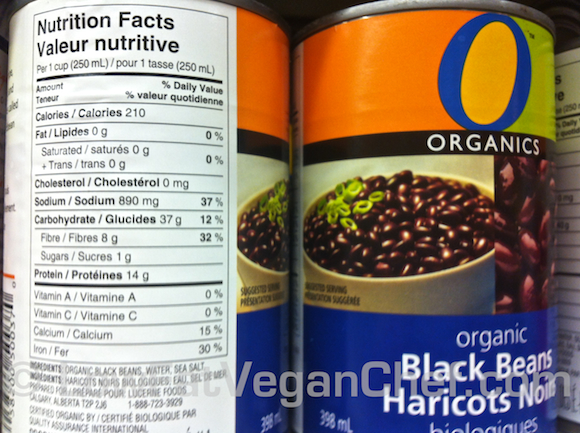
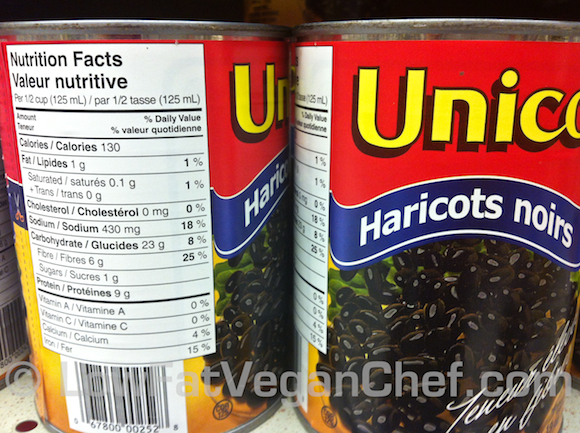
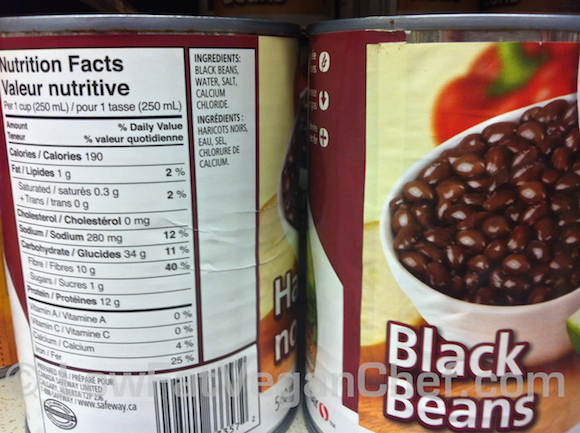

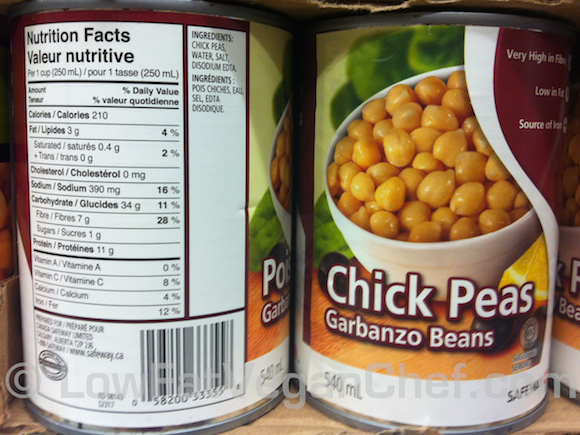
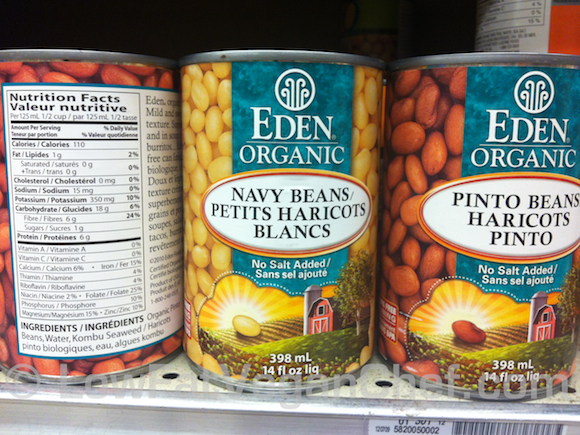
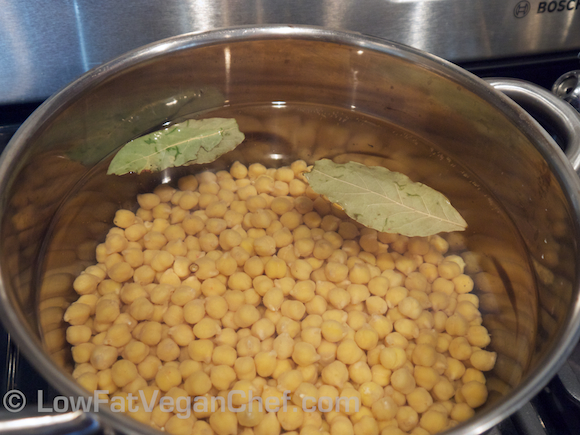
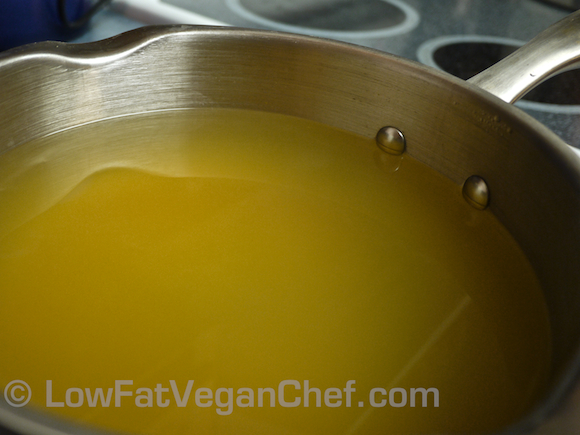
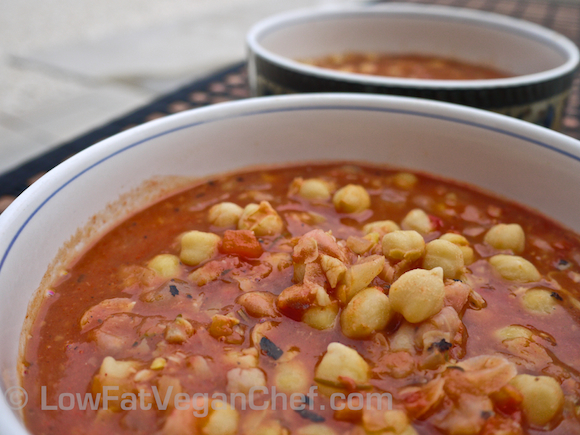
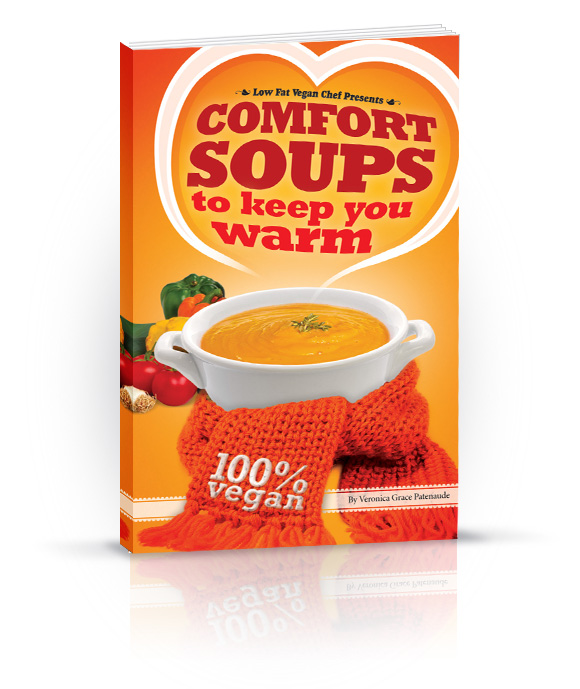
Whenever I ask my local grocery store to carry a product that I found in this site, they always ask first for the UPC number (number underneath the barcode). They tell me that without it they can’t order it. So if you could, please include the barcode in the pictured items if you can.
Sorry i don’t take pictures of UPC numbers/codes. Have you tried Amazon? Being able to goole or search them on Amazon should be easier in finding out where to buy them.
I’m a retired biochemist and I always read the entire label. I also but canned items with a non-bpa lining, although I’m beginning to research and question the new linings. I’ve started ordering organic, non-gmo dried beans and grains/seeds from amazon. Much cheaper. I can make a huge batch and freeze them. they’re much tastier too. I’m also concerned with the “cook-in-the-bag” frozen veggies. What chemicals leach from the bag into the food as it gets hotter and hotter in the microwave? I don’t trust the vendors to tell the truth.
I always check labels. These days more than I ever it seems like they
are adding more SODIUM and Potassium to ever kind of product
imaginable. I have been LUCKY, to find a local grocery store brand
of organic beans, that only contains 5% sodium. They have other organic
products like low sodium veggy broth and juices. Most of the other organic
brands are loaded with Sodium or Potassium and it makes no difference
what product your they are selling. Some that tout their healthy products
are worse than the big name brands, including the ADDED FATS. Just
because you go to a whole foods or health food store doesn’t mean its
HEALTHY. AGAIN, check the labels.
Good article, Veronica. Love your use of photographs!
Yes, I make a weekly bean pot from fried beans, but used canned ones for chilled bean salads & emergency chile. I *do* read labels …. for 4 main things (plus anything I can’t pronounce or that doesn’t sound like ‘food’)
1) added oil
(canned tomato sauce is another tight one – once, I sat for 15 minutes on the grocery store’s floor, comparing labels. Even those on Rip Esselsyn’s ‘approved list’ listed oil and/or butter. I started making my own – so easy – and, bought a tomato plant. Growing my own beans and squash, too, using the tomato plant’s cage for poles.
2) Sodium – what you say is so right! And, thank you for the insight about salt leading to over-eating. I’m one of the lucky ones – no high blood pressure (at least, not yet) – but still leaning my way to a healthier weight – had not heard that before. Sure, I realize salts cause fluid retention – but hadn’t ever heard they ‘lead to over-eating’ . I’ll ban the salt-shaker for a month and see what happens.
3) organic
AND
4) non-GMO
(lots of foods labeled ‘organic’ here (US) are not labeled ‘non-GMO’. When it comes to the bean, I’ll take the one and only carton labeled BOTH ‘organic’ and ‘non-GMO’ even if it’s not the category (silken, firm, etc) I really want. So frustrating – growing my own now.
Thanks Veronica for reminding us to check. I was worried but fortunately my go-to No Name Superstore (I am in Winnipeg) chickpeas are basically 1:1. They are also very inexpensive albeit not organic.
I see calium chloride in one of your cans and disodium EDTA in another. Many chick peas seem to have disodium EDTA. Are these ingredients okay?
So it looks like it’s used in food to keep metal ions in liquid for diminished reactivity. Although it could be harmful in large doses studies have shown that the dose found in products is much lower than levels found to be toxic. While I wouldn’t eat the exact same canned item every day, once in a while it shouldn’t be a problem. You can also cook your own beans from scratch as well.
http://en.m.wikipedia.org/wiki/Ethylenediaminetetraacetic_acid
Dear Veronica
Thank you for the info re canned beans.
I do look at labels and buy Chickpeas
with the least salt and extras listed.
I do not buy canned goods often,
so I am not affected so much.
Keep up your good work.
Warmest wishes
Margaret (NZ)
Hey Veronica, nice article. I’d like to ask you if you do take some animal products such as fish, eggs or dairy to keep your body weight in a normal range? I’ve been eating a low fat diet for over 2 years and vegan for over 4 years, and I can’t manage to keep my weight whatever I try. My BMI is less than 17, so I’m getting really concerned about being vegan. Prior to my vegan journey my BMI was in a healthy 20-21 range. I’ve taken a regular B12 supplement most of the time and it doesn’t seem to help at all. My iron is a bit low even though i ate at least 1-1/2 pounds of greens daily for the past 2 years, and I’ve spoken to my doctor, and he says I should incorporate red meat and chicken, but I would like to know if it’s possible to do this on a vegetarian or mostly vegetarian diet, and what are your thoughts on the link between the body weight and animal products.
Thanks in advance.
Hi Debra,
From my own personal experience and those of my clients (I am a Holistic Health Coach) Fat does not make you fat. Of course everyone is different but it sounds like since you are struggling with your weight you are one of those that metabolize fat better than a lot of carbs. Because I am plant based I eat Avocados, nuts, seeds and coconuts as my healthy fat source. The main source of my diet is dark leafy greens (green smoothies, big salads and steamed) low glycemic veggies, beans, the fats that I listed above and low sugar fruits like berries, grapefruit and apples. My ratios are more like 50-40-10. I have been able to maintain my perfect weight after struggling for years. The best thing to do is experiment and see what works for you.
Wishing you the best,
Dana
No I don’t eat animal products to keep weight on. Although I am not a doctor and cannot give medical advice, perhaps you are either not eating enough calories or you have an absorption issue and are not utilizing the nutrients that you are eating. You could try increasing your beans, legumes, lentils, and making sure to have at least 1-2 oz of nuts, seeds or avocado a day. You don’t need to be on a high fat diet and eat lots of fatty foods, but having a little bit more plant protein and fat might work for you. You haven’t really said anything about what you are eating and how many calories you are, so unfortunately I can’t really speculate any further.
I’m not a doctor either, but it dies sound like something could be missing from your diet. (Or, like Veronica said, maybe you aren’t metabolizing data properly?). What might be a typical week’s meal plan for you?
I recommend that you eat more potatoes, yams, and grains including whole grain breads. They should increase your weight a bit. I have an anorexis daughter…..be careful of that.
Not everyone is salt sensitive or needs to keep their intake really low. I have to use a fair amount in my cooking or my blood pressure goes too low. In fact my doctor told me to “eat more salt”.
This is a special circumstance. The majority of people have normal to high blood pressure not low. So adjust for your own needs
Very helpful! thank you!
The seaweed is not for flavor, but digestability. And, I do not see oil in any of the ingredient lists…..
I cook my own. I love how they turn out in the pressure cooker. The new pressure cookers are pretty easy to use and safe. Nothing like fresh butter soft chick peas with no added anything..:)
A Good re minder, something I forget to look for, thanks for the heads up , still haven’t got my recipe book which really would like. Keep up the good work.
I have to confess that since I started eating a plant based diet I have been rather lazy and relied a lot on canned beans. But analysing the cans of beans of several different brands in my pantry has been eye opening. The ratios of calories to sodium varied from at best to 1 : 1.9 for a can of chickpeas to a staggering 1 : 6.8 for a can of bean salad and an average of 1 : 3.5. (Actually the can of bean salad has been lingering in the back of the pantry for a long time because it’s twin tasted so yuck, as much as I hate to waste food I think it can go in the bin.)
Low or no sodium brands of most products aren’t common in New Zealand and I haven’t seen any in beans. So I think it’s definitely time I started cooking my own. And looking a lot more closely at labels.
Hi Veronica, I do read labels and sometimes I am more confused by what is IN the product. Especially with non-dairy milks. April 6 was my one year anniversary of eating a vegan diet so I’m still learning. Can you please explain the ingredients in alternative milks like almond, oat, soy etc.? Are they even healthy? Sometimes I think they might be just as damaging as dairy milk only for different reasons.
I know I can make my own nut milk but don’t always have time and it gets expensive buying good non-GMO nuts. BTW: Love your soup book. Every recipe I’ve made is delicious!
Hi Lia
I am not an expert on all the ingredients inside plant based milks, but I have inquired to several companies about their use of carageenan (a seaweed) that is controversial. While they argue it is in safe levels (and the experts such as Dr. McDougall, Jeff Novick and Dr. Esselstyn) are not concerned by it, some are moving to replace this ingredient and remove it. So Delicious has confirmed they are working towards this. Almond Breeze does not have any intention of doing this.
Making your own almond milk or rice milk is actually very easy. How To Make Raw Almond Milk You just have to rinse and soak some almonds, blend it together in a blender and then strain it and use within 3 days.
I’m not familiar with nuts being GMO, I live in Canada and there’s less information about this kind of thing at the grocery store. I think nuts are more expensive here too. I suggest looking online to buy bulk organic almonds, OR make your own rice or oat milk instead as it’s much more cost effective.
Thank you, Veronica! I’ve really ben watching my diet after being diagnosed with hypertension and sodium is definitely something I’m looking to avoid as much as possible. I often opt for dried and cook myself. Plus, you can add your own twist to beans from scratch like bay leaf, cummin, garlic, cayenne; I’ve even tried lemon grass. Good stuff! Thanks again; I’ve been enjoying your emails for a couple months now. Keep up the great word!
Thanks for the info Veronica! I live in a small community in the middle of nowhere and have less selection to choose from and I am saddened to say that I don’t always read the label. I would however, pay more for a product that is good for me. My husband complains about the cost but I say that a can of beans that costs me $5 feeds me 2 – 3 meals where his one steak costs $10+ and that is only one meal! Shuts him up pretty quickly when I add all of the health problems that you get from eating grocery store meat.
Thanks for this great post Veronica.
I have bought a can of red kidney beans which contains EDTA. Is it bad for you?
I have never heard of that before, so I am not an expert on that. Sorry.
EDTA is so bad McDonalds won’t use it. Yet it’s in a lot of packaged foods. Makes you think!
Great post! It really explains the sodium dilemma in an easy to understand way! Thank you for that!! I also prefer the Eden brand of beans for all of the reasons that you mentioned. And when I sometimes have a hard time finding them, I discovered they are also available on Vitacost for a discount! Also the Whole Foods little cartons of beans [found next to the cans] are great!
I try my best to make as much as possible from scratch. I can control the quality.
I love sites like yours that helps with this process of choices.
The rule of thumb I use that I picked-up from the book “eat to live” is that the mg of sodium should not exceed the calories. Like you, I put a lot of products that look good back on the shelf after reading the label.
But to your question, are high sodium organic black beans healthy? I don’t feel you can judge it by the label alone. It all depends on the calories it will replace in a person’s diet. If it replaces french fries or refried beans, then this is a healthier option. If it replaces low sodium black beans than it is not.
Any food high in sodium triggers you to eat more. Try eating plain vegetables or a plain baked potato and you aren’t likely to eat more than you are hungry for. As soon as you put salt on it and it becomes more palatable you can eat much more of it without thinking because you focus on taste. It’s well known that salty food causes people to overeat, so I don’t think that it should be argued that high sodium foods even if organic are healthy. They are not inherently healthy because of the high amount of unnatural sodium added and the fact that you’ll likely eat too much of it which Dr. Fuhrman doesn’t approve of either. I just think it’s best to put it back and look for a better choice. If 1 cup of those beans is added to your diet you could end up with 3000-4000 mg of sodium per day, far in excess to the daily recommendation of 1500 mg.
I can my own beans, squashes and other foods. I do not add salt or oil to my legumes. I love how my beans taste and the cost is a fraction of buying cans of cooked beans. 🙂
Thanks for the info Veronica:-)
I cook my own dry beans.
The O organic beans in California have less sodium then yours. black beans have 260mg and chickpeas 240mg per cup. Interesting how products with the same label vary so much
Are you sure they are exactly the same? It’d be interesting to see a picture of the label.
What brand was the 3rd option of black beans with low sodium?! I’d like to try that!
It’s Safeway brand
Doesn’t rinsing canned beans before using remove a lot of the sodium?
That only removes it from the liquid which isn’t much in the can. Taste the beans and you can tell they have absorbed most of the sodium, where as low sodium beans you won’t be able to taste hardly any. It’s better to buy low sodium, rinsing only takes off some surface amounts not what has been absorbed by cooking.
Also be careful to try to find non GMO. I understand that even things marked Organic can still have a high probability of being GMO in the bean category, and also products containing corn and/or soy of any kind. Sure makes buying food a challenge. Thanx for your help, as always.
In most countries organic foods do not contain gmos. This would more be a concern for prepackaged meals.
Labeling of GMO for fresh produce has an interesting twist. Sets of 4 numbers beginning with 3 or 4 are grown with chemical fertilizers and pesticides. The number indicates the specific produce grown and where. Sets of 5 numbers include the 4-number code with a number preceding the code. Those beginning with 8 are GMO produce generally grown the same ways as those beginning with 3 or 4. Anything grown organically, whether GMO or not, have numbers beginning with 9. I remember reading some time ago about GMO food producers who grew the produce organically stating that they should be coded as organically grown, so they are coded beginning with a 9. The producers themselves apply for the codes which you can look up [http://plucodes.com/search_wizard.aspx?s=1] and which often tell the location and farm name where the product is grown. They always tell the name of the produce, not just apples, but gala apples. The European countries demand that the GMO produce be identified, while the GMO designation in the USA slips by. How many codes have you seen beginning with an 8? I am wondering if there has been a change I had understood that codes beginning with a 5 were GMO grown with chemical fertilizers and pesticides. I have seen codes beginning with a 5 before in the stores. I have looked up the codes previously and don’t remember codes beginning with an 8. Now I am seeing 2 organizations for codes: Produce Marketing Association (PMA) [http://www.pma.com/about/history] and International Federation for Produce Standards [http://www.plucodes.com/]. I am wondering if the two organizations have adjusted their codes to be the same. I put the history link above as PMA has a 60-year history, which is interesting.
Excellent article! Thanks for all of this wonderful information.
Thank you for providing this information. The misinformation which manufacturers of food products are allowed to get away with is truly amazing. At times I think the protection of our foods is just as important as the police and fire departments. One thing which should be pointed out is the fact that beans are ridiculously easy to grow and either can or dry. This is one sure way of knowing what you are eating.
If you can grow them yourself sure. The growing season is extremely short where I am in Canada, we get late and early frosts so it’s not possible for me to grow all my own beans and peas.
In South Florida I have been fortunate in finding beans with NO salt added! I wish the stores would place all the no salt products in 1 area so I wouldn’t have to spend so much time reading so many products.
Its very Informative , dear V eronica . Thank You .
.
I rarelly read all the Labels , I have to confess .
I will be more Alert …
Respect ,
Teresa
Thank you very much. I especially appreciate you bringing our attention to the tricks that are being played with portion size. I sometimes find a package of something that I consider 1 portion, but it is actually 3.5 portions according to the package.
Yes they do this so they can get away with advertising something as fat free, low calorie, low in sodium, or healthy. When we all know someone is likely to eat the entire package which is no longer a snack but part of a whole meal.
I usually pay attention to the percentage rather than the quantity. I thought, this way you do not have to consider the based amount, irrespective of whether it is 1/2 or full cup. However , upon further inspection , the percentage is specifically of “Daily Value”. For clarity sake, I am curious if this would consider the percentage of the contents within the can as well.
The percentage is not a good way to measure anything, especially for women and children as most do not need 2000 calories a day. Jeff Novick talks about this in his lectures. Check out from Oil To Nuts. Especially when all foods are not equal in calories it’s really impossible to figure out if you’re getting the RDA, and in most cases you’re getting way more than that with too many calories, thus over feeding yourself. We want just enough, not too much “just to be safe”.
Look for a 1:1 or as close as you can get for calories to sodium. Higher sodium foods cause you to eat more as well.
thank you… my eyes will be wide open now
Hi, Veronica: This is a great post, and yes I read the labels, but this clarification of 1:1 ratio is very good, and one I will watch more diligently. However, I do like cooking my own beans at home!
Thank you for your insights and help.
thanks for the information. I thought I was good at reading labels, but you made me realize I need to pay much more attention to the sodium content.